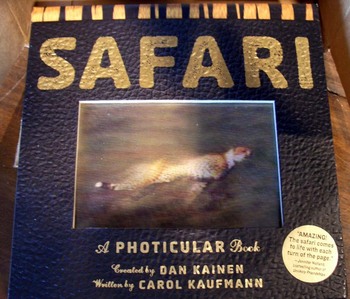Dan Kainen and Carol Kaufmann, Safari: a Photicular Book (New York: Workman Pub., 2012). Graphic Arts Collection 2013- in process.
Safari recently joined our collection of optical devices. Photographer and lighting expert Dan Kainen created the plates and Carol Kaufmann, a staff writer for National Geographic, wrote the commentary.
Kainen has a small website, http://www.dankainen.com/index.htm, where he describes his process. “Photicular, also known as Lenticular, or Integrated Photography, was first conceived in the early 20th century, but the basic concept has been around since 1692 when a French painter created paintings that revealed one, and then the other as the observer walked by. The simplest form of it is to cut two images into thin vertical strips and interleave them, placing in front of the composite image a plane of bars, like a picket fence, which only allows one to see one image at a time though the gaps. Instead of bars, lenses can be used, and more than two images - as many as dozens - can be interleaved.”
A lenticular image can easily be made using Photoshop and a number of tutorials are available on the internet. An image is broken into layers that are viewed from slightly different angles, tricking the eye into thinking the image is moving. Here’s one site: http://www.vicgi.net/lenticular-interlacing-algorithm.html
As an interesting sidebar, Kainen is the son of the painter and printmaker Jacob Kainen (1909-2001). In the 1930s, Jacob was a member of the Graphic Arts Division of the WPA and from 1942 to 1970, curator of the Division of Graphic Arts at the Smithsonian Institution. As the divisions of the Smithsonian grew, his collection moved to the Museum of History and Technology (now the National Museum of American History).
